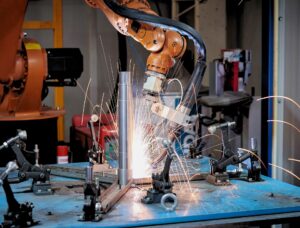Weld failures can be catastrophic—causing structural collapses, safety hazards, or costly rework. Whether you’re fabricating pipelines, aerospace components, or structural frames, weld integrity is non-negotiable. Understanding the common causes of weld failures and how to prevent them is key to ensuring safe, long-lasting, and high-quality welds. In this guide, Explore the common causes of weld failures and how to prevent them and how welding cameras and how welding cameras and weld inspection techniques help detect them.
What Is Weld Failure?
A weld failure occurs when a welded joint loses its strength or breaks under stress. Failures may happen immediately (during or right after welding) or gradually (under repeated use or harsh environments). Most weld failures are a result of weld defects, poor welding practices, or inadequate inspection.
Common Causes of Weld Failures
1. Porosity
Porosity happens when gas becomes trapped in the weld metal, creating cavities or voids.
Causes:
- Contaminated base or filler metal
- Improper shielding gas
- Excessive arc length
Solution:
- Clean the workpiece thoroughly
- Use proper shielding gas (especially in TIG welding and MIG welding)
- Monitor arc behavior with a welding camera to catch porosity formation in real time
2. Cracks
Cracks are among the most dangerous weld defects. They can be surface-level or internal and often lead to sudden failure.
Causes:
- High residual stress
- Poor fit-up or joint design
- Improper cooling or heat input
Solution:
- Use proper joint preparation and preheating
- Avoid rapid cooling
- Utilize weld monitoring systems to manage temperature and heat input effectively
3. Lack of Fusion
This occurs when the weld metal fails to bond properly with the base metal or between weld passes.
Causes:
- Incorrect welding angle or speed
- Low heat input
- Contaminated base material
Solution:
- Adjust travel speed and electrode angle
- Use real-time arc welding images to monitor bead fusion
- Apply welding visual inspection techniques to verify coverage
4. Slag Inclusion
Non-metallic materials (like flux) become trapped in the weld metal, weakening the joint.
Causes:
- Improper cleaning between passes
- Incorrect electrode handling in metal arc welding
- Inadequate penetration
Solution:
- Clean slag thoroughly before multi-pass welding
- Monitor weld quality using a weld inspection camera
- Choose the right parameters in MIG and MAG welding process and plasma arc welding
5. Undercut
Undercutting is a groove that forms along the edges of the weld, reducing the thickness and strength of the joint.
Causes:
- Too high voltage or travel speed
- Incorrect technique or angle
- Poor welder visibility
Solution:
- Use appropriate settings and torch angle
- Train operators with help from welding monitoring systems
- Leverage cameras for welding to improve visual guidance in real time
How Welding Cameras Help Prevent Weld Failures
Modern weld monitoring cameras provide a powerful way to catch issues before they become failures. From operator training to real-time inspection, they offer:
✅ Live arc monitoring to spot porosity, lack of fusion, or excessive spatter
✅ Weld documentation and traceability for quality control
✅ Improved visibility in hard-to-see or high-risk weld zones (e.g., confined spaces or robotic welding setups)
✅ Feedback for correcting torch angle, travel speed, and arc length
Some high-speed arc welding image systems even allow you to pause, zoom, and analyze micro-defects, helping prevent hidden issues from going unnoticed.
Best Practices to Prevent Weld Failures
- Follow a Welding Procedure Specification (WPS): Consistency in settings, materials, and sequence is critical.
- Use the Right Welding Technique: Match the welding process (e.g., TIG welding, MIG welding, or laser welding) to the job’s needs.
- Train Operators: Ensure your team understands the root causes of weld problems and how to mitigate them.
- Inspect Early and Often: Combine welding inspection techniques like dye penetrant, ultrasonic, and visual inspection with camera systems for better QA.
- Monitor Every Weld: Invest in a weld monitoring system for process optimization and real-time detection of deviations.
Conclusion: Detect Early, Prevent Completely
Weld failures aren’t just about poor welds—they’re about avoidable losses, downtime, and risks. By understanding the common causes and leveraging technology like welding cameras, fabricators can detect problems in real time, maintain control over every weld, and reduce the risk of failure dramatically.
Whether you’re in oil & gas, construction, aerospace, or manufacturing, Mecaweld’s advanced weld inspection tools help improve consistency, reduce rework, and enhance welding quality from the inside out.
Ready to stop weld failures before they start? Contact us today to learn how our welding camera solutions can protect your projects, your team, and your bottom line.



